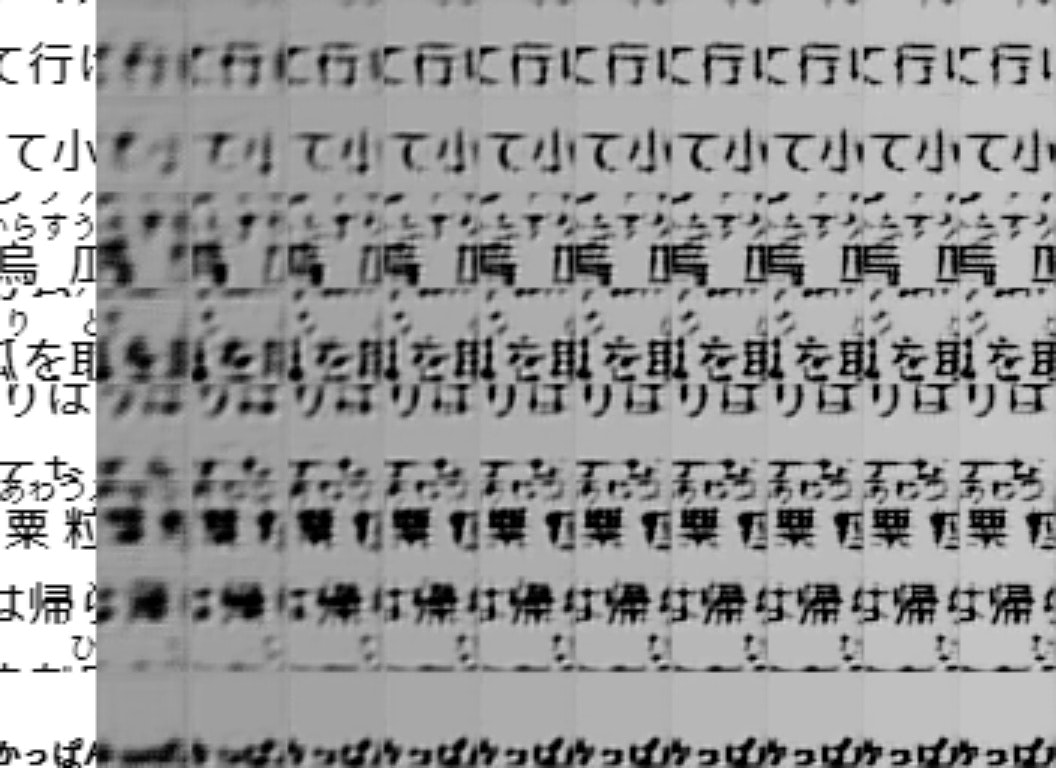Chainerにはextensions.snapshot()というスナップショットを出力する機能があるので、それを使って学習の推移を比較したい。ソースコードはここ
【追記】predictorの前にwith chainer.using_config('train', False):を設定しないと誤差伝番が実行されてしまうので注意
動作環境
- Ubuntu 16.04.3 LTS
- Python 3.5.2
- chainer 3.2
- opencv-python 3.2
実行イメージ
一番左が正解画像で、右に行くほど学習が進んだスナップショットとなる。学習が進むほど文字がシャープになっているのが確認できる。
コード
メイン部 main()
[1]でネットワーク層を設定、[2]で入力する画像の生成、[3]でスナップショットを呼び出し学習モデルの生成と推論実行、[4]で各スナップショットから生成された出力画像を連結し、表示と保存を実行する。
predict_some_snapshot.py
import cv2
import numpy as np
import chainer
import chainer.links as L
from Lib.network import JC
import Lib.imgfunc as IMG
import Tools.func as F
from predict import getModelParam, predict, isImage, checkModelType
def main(args):
# [1]
snapshot_path, param = getSnapshotAndParam(args.snapshot_and_json)
unit, ch, layer, sr, af1, af2 = getModelParam(param)
model = L.Classifier(JC(
n_unit=unit, n_out=ch, layer=layer, rate=sr,
actfun_1=af1, actfun_2=af2
))
# [2]
img = getImage(args.jpeg, ch, args.random_seed)
out_imgs = [img]
# [3]
for s in snapshot_path:
load_path = checkModelType(s)
try:
chainer.serializers.load_npz(s, model, path=load_path)
except:
import traceback
traceback.print_exc()
print(F.fileFuncLine())
exit()
if args.gpu >= 0:
chainer.cuda.get_device_from_id(args.gpu).use()
model.to_gpu()
with chainer.using_config('train', False):
out_imgs.append(predict(model, args, img, ch, -1))
# [4]
img = stackImages(out_imgs, args.img_rate)
cv2.imshow('predict some snapshots', img)
cv2.waitKey()
cv2.imwrite(F.getFilePath(args.out_path, 'snapshots.jpg'), img)
推論実行 predict()
predict()をはじめとしたいくつかの関数は自作である。ソースコードは同じリポジトリにある。[1]で画像を圧縮して劣化させ、[2]で分割する。[3]でバッチサイズごとに実行し、[4]で分割した画像を再度結合し、[5]でサイズを入力画像と同じにして[6]で保存する。
predict.py
import cv2
import numpy as np
import chainer
import chainer.links as L
from chainer.cuda import to_cpu
from Lib.network import JC
import Lib.imgfunc as IMG
import Tools.func as F
def predict(model, args, img, ch, val):
org_size = img.shape
# [1]
comp = IMG.encodeDecode([img], IMG.getCh(ch), args.quality)
if(val >= 0):
cv2.imwrite(
F.getFilePath(args.out_path, 'comp-' +
str(val * 10).zfill(3), '.jpg'),
comp[0]
)
# [2]
comp, size = IMG.split(comp, args.img_size)
imgs = []
# [3]
for i in range(0, len(comp), args.batch):
x = IMG.imgs2arr(comp[i:i + args.batch], gpu=args.gpu)
y = model.predictor(x)
y = to_cpu(y.array)
y = IMG.arr2imgs(y, ch, args.img_size * 2)
imgs.extend(y)
# [4]
buf = [np.vstack(imgs[i * size[0]: (i + 1) * size[0]])
for i in range(size[1])]
img = np.hstack(buf)
# [5]
h = 0.5
half_size = (int(img.shape[1] * h), int(img.shape[0] * h))
flg = cv2.INTER_NEAREST
img = cv2.resize(img, half_size, flg)
img = img[:org_size[0], :org_size[1]]
# [6]
if(val >= 0):
name = F.getFilePath(args.out_path, 'comp-' + str(val * 10 + 1).zfill(3), '.jpg')
print('save:', name)
cv2.imwrite(name, img)
return img
以上。
